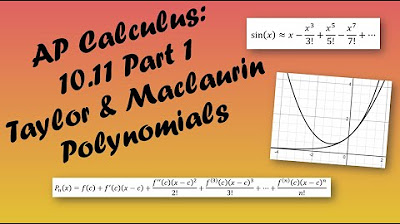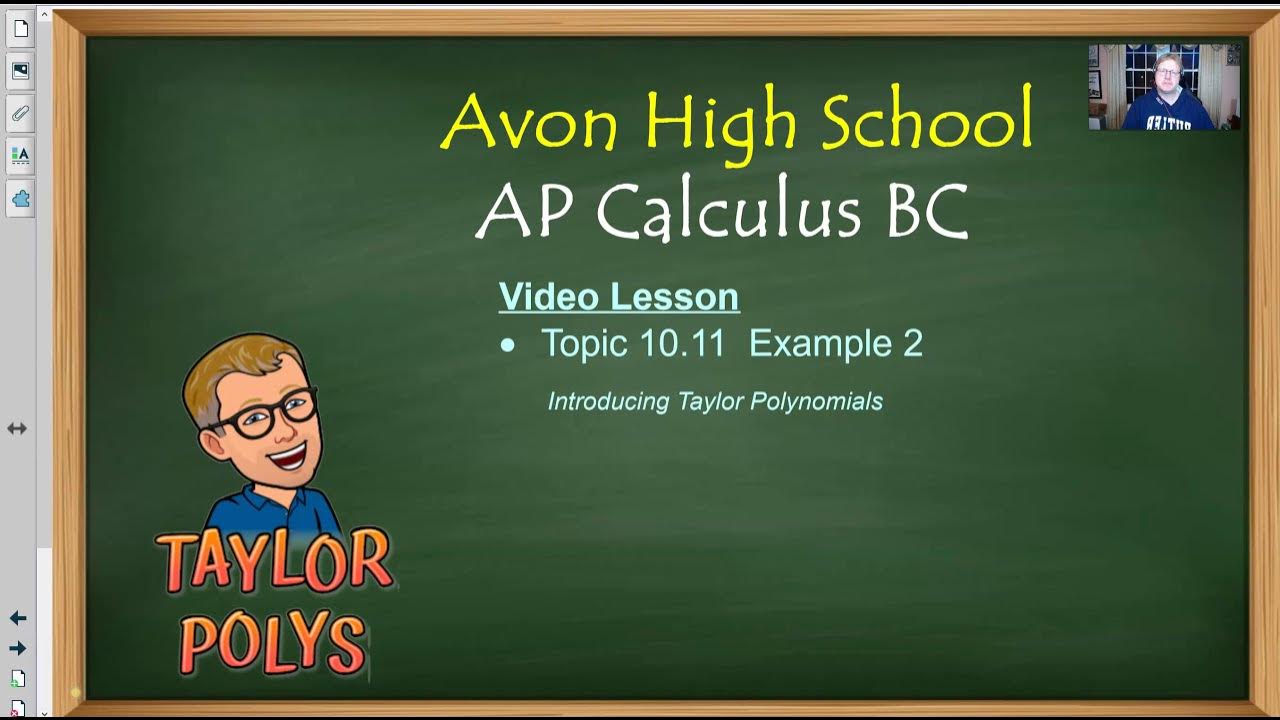Taylor & Maclaurin polynomials intro (part 2) | Series | AP Calculus BC | Khan Academy
TLDRThe video script discusses the concept of approximating differentiable functions using polynomials, specifically focusing on the Taylor expansion around a general point 'c'. It begins with the basic approximations using zero-degree and first-degree polynomials, then moves on to second and third-degree polynomials for better precision. The script explains how to match the function's value and derivative at point 'c' to create a more accurate polynomial approximation. It concludes by introducing the general Taylor expansion formula, highlighting its effectiveness in approximating functions around arbitrary values, not just at x=0.
Takeaways
- 📚 The concept of approximating differentiable functions using polynomials is discussed, with a focus on extending the Taylor series beyond just around x=0.
- 🔍 The video builds upon previous knowledge of Maclaurin series, aiming to generalize the Taylor expansion for any value of x, not limited to x=0.
- 📈 The script explains that a zero-degree polynomial (constant) can be used for initial approximation, but it is not very accurate.
- 🚀 As the degree of the polynomial increases, the approximation becomes better, with a first-degree polynomial capturing the slope and a second-degree polynomial hugging the function longer.
- 🌟 The Taylor expansion at x=c is achieved by matching the function value and its derivative at c, leading to a more accurate approximation.
- 📊 The polynomial approximation p(x) is derived as f(c) plus the first derivative f'(c) times (x-c), ensuring that both the value and the slope match at x=c.
- 🔢 By taking the derivative of the polynomial, it's shown that p'(x) equals f'(c), confirming that the second constraint of matching the derivative is met.
- 📝 The general Taylor expansion formula is presented, with p(x) expressed as a sum involving the function's value and its derivatives at c, multiplied by powers of (x-c) and divided by factorials.
- 💡 The Taylor series becomes more complex as more terms are added, due to the need to calculate higher-order derivatives and expand binomials.
- 🎯 The accuracy of the approximation increases with the addition of more terms, allowing for better representation of the function for arbitrary values of x.
- 📱 The next video will demonstrate the application of these concepts using WolframAlpha, showcasing the practical use of Taylor expansions.
Q & A
What is the main topic of the video script?
-The main topic of the video script is the Taylor expansion, a method to approximate differentiable functions using polynomials around a given point x=c, as opposed to just around x=0 as in the Maclaurin series.
How does a zero-degree polynomial approximation compare to a first-degree polynomial approximation?
-A zero-degree polynomial approximation is simply a constant horizontal line that goes through the point, which is not a great approximation. In contrast, a first-degree polynomial can capture the slope of the function at that point, providing a better approximation.
What is the significance of the second-degree polynomial in function approximation?
-The second-degree polynomial allows the approximation to hug the function a little longer than a first-degree polynomial, offering a more accurate representation of the function's behavior around the point of interest.
How does the Taylor expansion differ from the Maclaurin series?
-The Taylor expansion generalizes the concept of the Maclaurin series, which is specific to approximations around x=0, by allowing the approximation to occur around any given point x=c.
What is the first step in constructing a Taylor expansion for a function?
-The first step is to ensure that the polynomial approximation at c is equal to the function value at c, which is f(c).
What condition does the first-degree Taylor expansion satisfy?
-The first-degree Taylor expansion satisfies the condition that the polynomial value at c is equal to the function value at c, and its derivative at c matches the function's derivative at c.
How does the Taylor expansion handle higher-order derivatives?
-The Taylor expansion includes higher-order terms that involve the function's second, third, and further derivatives evaluated at c, divided by the corresponding factorials and multiplied by powers of (x-c).
What is the general form of the Taylor expansion for a function f(x) around a point c?
-The general form is p(x) = f(c) + f'(c)(x-c) + (f''(c)/2!)(x-c)^2 + (f'''(c)/3!)(x-c)^3 + ... , where f'(c), f''(c), etc., represent the first, second, and further derivatives of the function evaluated at c.
How does the Taylor expansion improve as more terms are added?
-As more terms are added to the Taylor expansion, the polynomial approximation becomes more accurate, better capturing the function's behavior around the point x=c.
What is the main challenge when expanding the Taylor series around a non-zero point?
-The main challenge is the increased complexity of the mathematical operations, particularly when dealing with higher-order derivatives and the expansion of binomials in the polynomial terms.
Outlines
📚 Introduction to Function Approximation and Taylor Series
This paragraph introduces the concept of approximating an arbitrary function, particularly one that is differentiable multiple times, using a polynomial. It explains the process of approximating a function around x=0 using polynomials of varying degrees, from zero-degree (constant) to higher degrees that better hug the function's curve. The focus is on the Maclaurin series or the Taylor series at x=0 and the desire to generalize this concept to approximate the function around any value x=c. The explanation includes setting up the polynomial to match the function's value and derivative at c, resulting in a better approximation of the function.
🔢 Deriving the General Taylor Expansion
This paragraph delves into the derivation of the general Taylor expansion for approximating a function around a given value x=c. It discusses the process of adding more terms to the polynomial to improve the approximation, following the same logic as in the Maclaurin series but adjusted for the arbitrary value c. The explanation includes the construction of the polynomial using the function's value and derivatives at c, and how the polynomial's derivative matches the function's derivative at c. The paragraph also touches on the complexity of calculating higher-order derivatives and the resulting polynomial's form, emphasizing that adding more terms will yield a better approximation of the function.
Mindmap
Keywords
💡Approximation
💡Polynomial
💡Differentiable
💡Maclaurin Series
💡Taylor Series
💡Derivative
💡Slope
💡Zero-degree Polynomial
💡First-degree Polynomial
💡Second-degree Polynomial
💡Third-degree Polynomial
Highlights
The concept of approximating differentiable functions using polynomials is introduced.
A zero-degree polynomial, or a constant, can be used as the simplest form of approximation.
A first-degree polynomial can capture the slope of the function at a given point.
Second-degree polynomials provide a better approximation by hugging the function for a longer interval around the point x=0.
The general idea of Taylor expansion at a point x=c is discussed, moving beyond the Maclaurin series which is centered at x=0.
The Taylor expansion at x=c involves matching the function's value and derivative at the point c.
The polynomial approximation at c is guaranteed to be equal to the function's value at c.
The derivative of the polynomial approximation at c is shown to be equal to the function's derivative at c.
The general Taylor expansion for a function f(x) around c is presented as a polynomial.
The Taylor expansion includes higher-order terms involving the function's derivatives and binomial coefficients.
The complexity of the Taylor expansion increases with each additional term due to the expansion of binomials.
The Taylor expansion provides a more accurate approximation of the function as more terms are added.
The Taylor expansion can be used to approximate the function around an arbitrary point x=c, not just at x=0.
The process of deriving the Taylor expansion is analogous to the Maclaurin series derivation.
The Taylor expansion is a powerful tool for function approximation and has practical applications in various fields.
Transcripts
5.0 / 5 (0 votes)
Thanks for rating:





